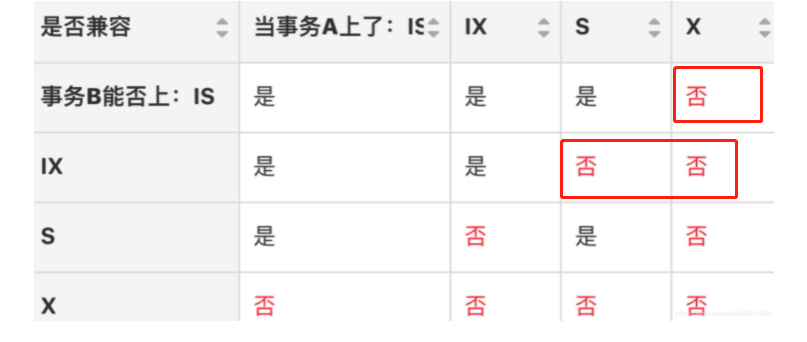一、定义:
S锁:共享锁,行级锁,已加S锁的行,不允许其它事务再加X锁,但可以继续加S锁
X锁:排它锁,行级锁,已加X锁的行,不允行其它事务再加S或X锁
IS:意向共享锁,表级锁,已加S锁的表,肯定会有IS锁,反过来,有IS锁的表,不一定会有S锁
IX:意向排它锁,表级锁,已加X锁的表,肯定会有IX锁,反过来,有IX锁的表,不一定会有X锁
二、准备工作
我使用的MySQL版本为8.0.26
我使用的是MySQL Workbench 开两个连接,并确保隔离级别为RC,因这篇文章主要讲RC
所以请注意,后面讲产生的锁的情况如果没有特别标注,都是在RC隔离级别下。
先查看
select @@global.transaction_isolation,@@transaction_isolation;
复制查看结果
REPEATABLE-READ REPEATABLE-READ
将当前session隔离级别改为 RC
set session transaction isolation level read committed;
复制三、测试数据
为了读者可复现,我这里先构造数据
CREATE TABLE `test_store` (
`tid` int(10) unsigned NOT NULL,
`storeid` int(10) unsigned NOT NULL COMMENT '仓库ID',
`storecode` varchar(50) NOT NULL COMMENT '仓库编号',
PRIMARY KEY (`tid`,`storeid`)
) ENGINE=InnoDB DEFAULT CHARSET=utf8;
insert into test_store
select 1,2,'bb'
union all
select 1,1,'AA';
CREATE TABLE `test_goodsbound` (
`tid` int(10) unsigned NOT NULL,
`goodsid` int(10) unsigned NOT NULL,
`storeid` int(10) unsigned NOT NULL,
PRIMARY KEY (`tid`,`goodsid`,`storeid`),
KEY `fk_goodsbound_storeid` (`tid`,`storeid`),
CONSTRAINT `fk_goodsbound_storeid` FOREIGN KEY (`tid`, `storeid`) REFERENCES `test_store` (`tid`, `storeid`) ON DELETE NO ACTION ON UPDATE NO ACTION
) ENGINE=InnoDB DEFAULT CHARSET=utf8;
insert into test_goodsbound
select 1,1,1 union all
select 1,2,1 union all
select 1,3,1;
复制四、产生锁的行为
什么行为会产生S锁?
1、主动 在select 后添 加 lock in share mode
begin;
select 1 from test_goodsbound where tid = 1 lock in share mode
复制然后查看锁的情况,如下图
select * from performance_schema.data_locks;
复制
可以看到在相关的上加了S锁,表上也有了IS锁
2、对含有外键的表进行修改,会让外键对应的表加上S锁
参看上面的表结构,test_goodsbound 表存在一个外键 fk_goodsbound_storeid
begin;
update test_goodsbound set goodsid =10 where tid = 1 and goodsid = 3
复制然后查看锁的情况,如下图
select * from performance_schema.data_locks;
复制
看第4行数据,test_store表 的tid = 1 storeid = 1的行 添加了S锁、当然第一行也对 test_store表添加了 IS锁
外键只有insert,update表才会对外键数据所对应的主键表所在的行 增加 S锁。
delete 不会产生
begin;
delete from test_goodsbound
复制然后查看锁的情况,如下图
select * from performance_schema.data_locks;
复制
这个也是我不推荐使用数据库外键约束的原因。增加S锁,就增大了死锁概率。让应用自己检查判断保证完整性。
3、在RR上还有一次情况会产生S锁
先将改隔级别改为 RR
set session transaction isolation level REPEATABLE READ
复制执行下列语句
INSERT INTO test_goodsbound2(tid,storeid,goodsid)
select tid,storeid,goodsid from
(
select tid,storeid,goodsid,sleep(10) from test_goodsbound limit 100) as t
复制在另一个连接上查看锁的情况
select * from performance_schema.data_locks;
复制
隔10秒后,再执行

你会发现,多了一行。 所以只有这种情况很特殊,select 扫一行,就会添加一行的S锁。
什么行为会产生X锁?
1、主动 在select 后添加 for update
begin;
select * from test_goodsbound where tid = 1 and goodsid = 1 for update
复制然后查看锁的情况,如下图
select * from performance_schema.data_locks;
复制
如果所涉及的查询或修改走了二级索引,则会连二级索引一起上锁。
explain
select * from test_goodsbound where tid = 1 and storeid = 1 for update
复制
可以看到 这个select语句,走了二级索引
begin;
select * from test_goodsbound where tid = 1 and storeid = 1 for update
复制然后查看锁的情况,如下图
select * from performance_schema.data_locks;
复制
会看到,主键索引与二级索引相关行上都添加了X锁
2、执行 insert,update,delete语句,对所涉及的行
begin;
delete tg from test_goodsbound as tg force index(fk_goodsbound_storeid ) where tid = 1 and storeid = 1
复制我这里强制走了二级索引 fk_goodsbound_storeid
然后查看锁的情况,如下图
select * from performance_schema.data_locks;
复制
五、兼容与互斥
贴一个兼容表格

我对红框中的互斥做一个试验
先产生一个只有IS锁的 事务
begin;
select * from test_goodsbound where tid = 1 and storeid = 2 lock in share mode
复制然后查看锁的情况,如下图
select * from performance_schema.data_locks;
复制
打开另一个连接,执行
insert into test_goodsbound
values(1,1,2);
复制再执行
delete from test_goodsbound where tid = 1 and storeid = 2
复制都是可以执行的。
所以我认为,如果只有IS锁,没有对应的记录有S锁,那么IS 与 行X是不互斥的,但与表X是互斥的。
我们再来检查一下,IX与X与S的互斥
begin;
select * from test_goodsbound where tid = 1 and storeid = 2 for update
复制然后查看锁的情况,如下图
select * from performance_schema.data_locks;
复制
同样,在另一个连接中去执行
打开另一个连接,执行
insert into test_goodsbound
values(1,1,2);
复制再执行
delete from test_goodsbound where tid = 1 and storeid = 2
复制都是可以执行的。
所以我同样认为,如果只有IX锁,没有对应的记录有X锁,那么IX 与 行S和行X是不互斥的,但与表X与表S锁是互斥的。
2024-05-17更新
因为IX与IS是表级锁,而S与X锁即有表级也有行级,表格上没有区分出来
IX与表级S锁与X锁是互斥的,与行级S与X是不互斥的
IS与表级X锁是互斥的,与行级S与X是不互斥的
另外的互斥,我就不一一试验了。
如文章中有问题,也欢迎大家指正。谢谢。
欢迎大家关注我的微信公众号,分享MySQL相关知识

评论
 1
1 点赞
点赞 点赞
点赞











